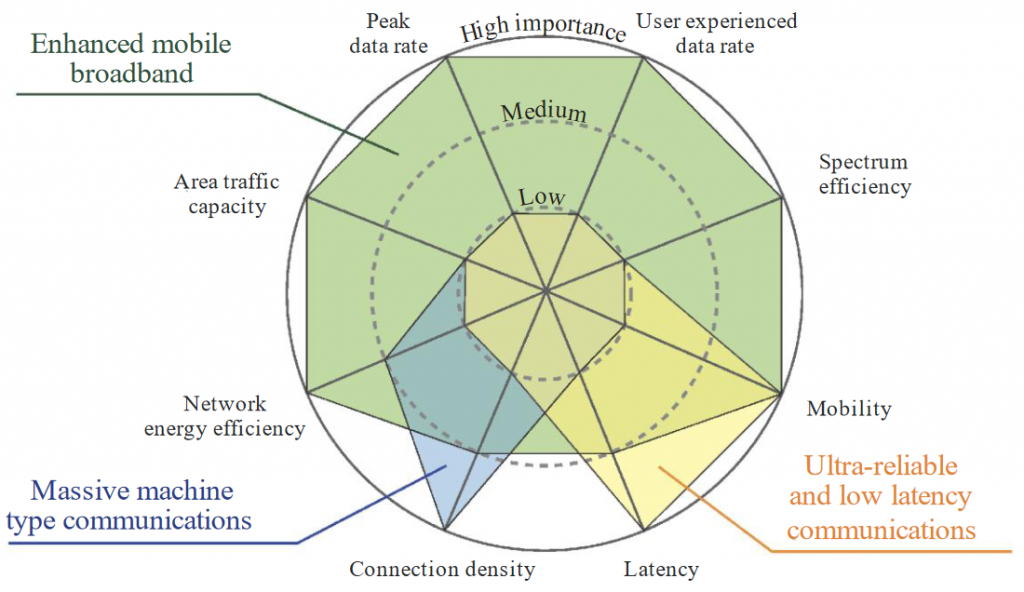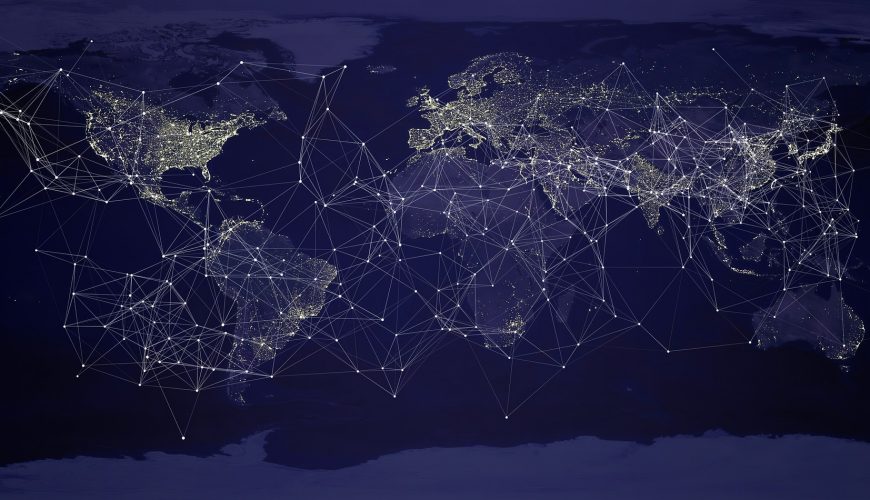The next generation of wireless communication is about to become reality. Mobile operators are investigating new infrastructure and phone manufacturers will start to roll out 5G-ready phones already this year. This generation has been in development for many years but the first specifications were released by 3GPP (Third Generation Partnership Program) in late 2018. It has since then been a race to offer the first 5G service. However, this is the very beginning of 5G and what is yet to come will be revealed in coming releases.
This article will quickly go through all parts that will create 5G. It will also give examples of how it will be used and short summary of what previous generations have offered.
1G, 2G, 3G, 4G … 5G
In the past, we have had several wireless technologies leading up to today. These have been categorized into generations ranging each about 10 years in time.
Starting from the 80’s we had the introduction to cellular communication, giving us the possibility to make wireless calls with semi-portable phones at an extreme cost. This is often regarded as the first generation since it was the first one to introduce the cellular concept.
The second generation moved from using analog communication to digital communication, it was also the generation in which mobile phones became affordable and widespread in Europe and North America.
In 1998, the third generation was released which had a big success and downfall due to heavy investments during the dot-com bubble. It was also the technology that introduced phones to the internet, via the short-lived WAP protocol, for those who remember.
Today’s mobile communication is in most major cities based on 4G. It made the real breakthrough of mobile internet. Which together with smartphones have enabled high-quality video streaming and applications like Instagram, Snapchat, and Uber.
|
Generation |
Technology Standards |
Released |
Rate |
No. Devices |
|
1G |
AMPS, NMT, TACS |
1979 |
Analog voice |
? |
|
2G |
GSM/GPRS, CDMA |
1991 |
~1 kbit/s |
200 Million |
|
3G |
WCDMA, CDMA2000 |
1998 |
~1 Mbit/s |
5 Billion |
|
4G |
LTE, Cat-M, NB-IoT |
2008 |
~1 Gbit/s |
10 Billion |
|
5G |
NR |
2019 |
>10 Gbit/s |
> 30 Billion |
New Technologies
With the fifth-generation wireless networks, of course, higher data rate to a lower cost will be a key improvement, but it will also introduce new types of use cases. In the following figure you can see the three main use cases: Enhanced Mobile Broadband (eMBB), Massive Machine Type Communications (mMTC), and Ultra Reliable Low Latency Communications (uRLLC). As well as what improvement areas they will require from the 5G network.

Figure: ITU-R M.2083-04
mmWave
As higher demand on data rates goes up, so does the price on the spectrum (e.g. US operators bought 280 MHz new spectrum for 81 billion USD 2021). To meet this, an expansion of the available spectrum will be made. This spectrum will be found in bands at 24-30 GHz and 37-40 GHz, but the release of more spectrum is being discussed.
These bands are located at frequencies called millimeter wave (mmWave) since their wavelengths are in the order of a millimeter. Since the wavelengths are so small, it makes signals not reach very far and be sensitive to the environment such as buildings, moving objects as well as rain and snow. This makes it important to have base stations in line of sight to the user, or with the possibility to reflect just a few times. So to solve this an increased number of base stations in dense cities will be deployed, so each cell becomes smaller.
One positive thing is that size of antennas becomes smaller with higher frequency. So mmWave radios can be created very small to fit in urban areas.
Massive MIMO
Except to open up new available spectrum, it is also important to increase the efficiency of the spectrum i.e. (bits/s)/Hz, to meet the demand for more data. This will be done by an evolution of Multiple Input Multiple Output (MIMO). This is the concept of using multiple antennas to transmit and receive data. MIMO has already been used before, but 5G will take it to the next level by increasing the number of antennas significantly, therefore called massive MIMO (mMIMO).
In the simplest case, we can adjust the phase going out on each antenna such that they combined create a beam directed to the user. However, in the case of no line-of-sight to the user, the antennas will still transmit such that the waves add up constructively at the user and destructively elsewhere, but it will not create a single beam.
This concept is introducing space (spatial dimensions) as an extra physical resource to use for information. In addition to the traditional time and frequency resources used today. With the use of mMIMO, the spectral efficiency can be increased more than 100 times, which is why it will be the main technology for eMBB.
Low Latency
The time it takes for a device (e.g. mobile phone) to send a signal over the air to a radio receiver, transported and registered in the core network, is called latency. For current 4G networks latencies are about 20 ms. But in 5G it can be reduced to as low as 1 ms.
Even if mmWave will reduce the time for signal propagated over the air by more than a half. It adds just less than 1 ms in latency. So the majority of latency comes from processing within the network.
This is what a new concept called Network Slicing will solve. It will make it possible to group up different applications into categories, so they then can be allocated resources to only be used within the category. This will avoid that mission-critical applications like autonomous driving need to wait for regular applications like youtube before their information can be sent or received.
Use cases of Ultra Reliable Low Latency Communications (uRLLC) will be a key factor to make cellular networks expand to more use cases beyond mobile phones.
Low Power
The third major use case for 5G is Massive Machine Type Communications (mMTC), also called Internet of Thing (IoT) or Machine-to-machine (M2M). This builds on the idea of connecting as much as possible to the network for data collection and smart control. It can be anything from connected vehicles, street lights, to agricultural sensor systems.
Communication between machines is not something new but it has previously been limited by the technology of battery energy, which now is getting much better. But also that cellular networks have been focusing on maximum performance. Two Radio Access Technologies (RAT) which were first introduced in LTE Advance but will be heavily used in 5G networks are CAT-M and NB-IoT.
They are similar to other RATs in LTE and NR but are utilizing much lower bandwidths (1.4 MHz and 180 kHz respectively). In return, it is possible to increase the spectral power density (W/MHz) for longer transmissions and very low requirements on end-point device complexity.
The most common use cases for NB-IoT include utility meters and sensors which are installed with only a single cell battery. Since Cat-M has a little more bandwidth it can support both voice call and positioning. Typical use cases are therefore e.g. connected vehicles and wearable devices.
When?

The first standards have now been finalized, but even before that, equipment vendors have been in the development of these systems since many years ago. I have only described a few of the most interesting changes but you can from this understand that there is a lot of different technologies that build up 5G. All of these will not be ready at the same time. Of course, it will also depend from country to country in terms of government push for opening new spectrum and how mature the customers are for new use cases.
Anyhow, we should be able to see the first mobile handsets as well as base stations very soon. South Korea seems to be the country to get a full 5G rolled out the fastest. With US, Japan, and China also rolling it out with high speed. Europe seems to be a bit behind on the investment as well as opening up a new 5G spectrum.
The heaviest investments from operators will be to create eMBB. It will require a replacement of radio equipment, which we should expect inner cities to have the first priority on. For support of mMTC, upgrades of existing equipment will be possible in some cases. How to create optimal network slicing for uRLLC is still in process but once it is ready it should also be possible to be an upgrade to existing infrastructure.
Now you hopefully know what will create 5G briefly. Some of the topics will be covered in-depth in upcoming articles. Please subscribe or follow on social media to get a notice.
